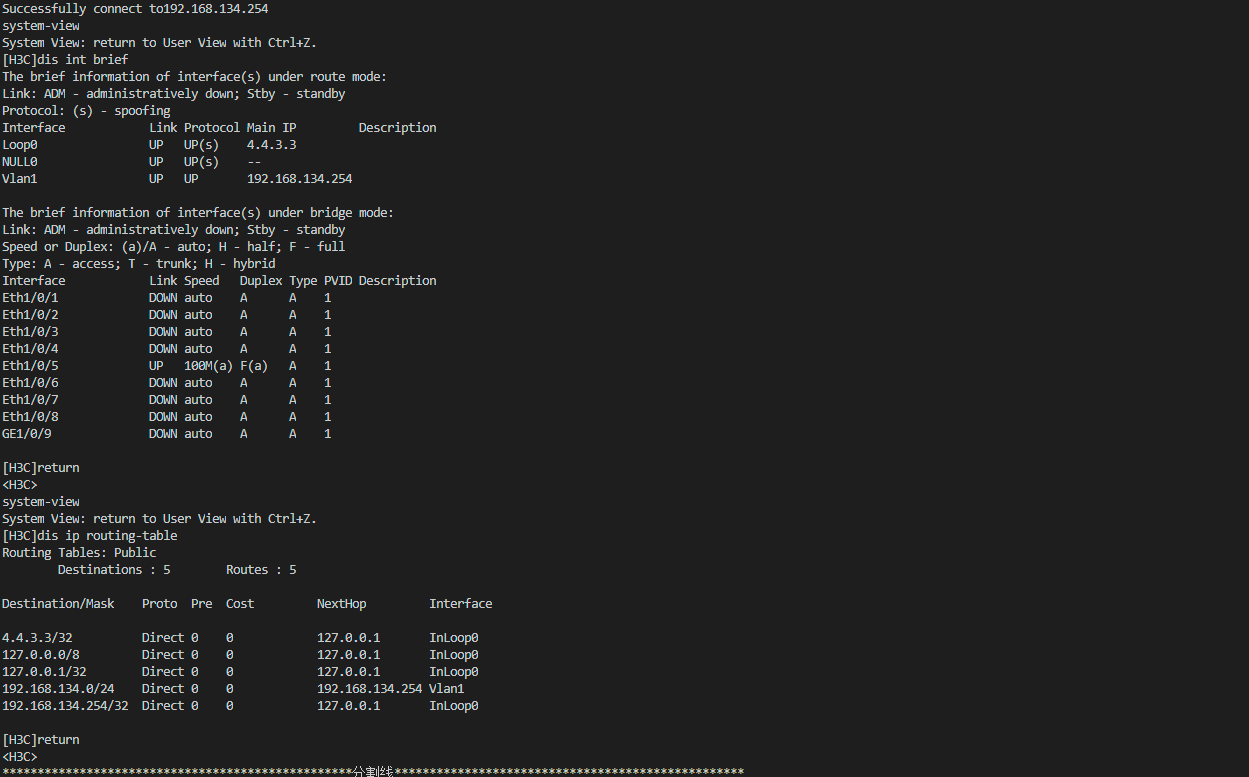关于使用python批量操作网络设备,这里本人目前只接触了两个模块,netmiko和pratmiko,后面的脚本也都将基于这两个模块。
一、netmiko模块
1、使用netmiko模块连接操作设备
import netmiko #导入netmiko模块
import time #导入time模块
#使用with语句打开用于ssh连接所需要的相关信息(用户名,密码,ip地址,需要配置的命令),这个打开了两个文件用户信息文件,命令文件,分别命名为devices_file,cmd_file
with open("ip_user_pass.txt", "r") as devices_file, open("cmdlist.txt", "r") as cmd_file:
#将用户信息文件按行读取赋值给devices
devices = devices_file.readlines()
#将命令文件按行读取赋值给cmdlist
cmdlist = cmd_file.readlines()
#使用循环将用户名,密码,IP地址,分别赋值给username,password,ip_address变量,并依次登陆
for line in devices:
line = line.strip("
")
ip_address = line.split(",")[0] #split() 通过指定分隔符对字符串进行切片,如果参数 num 有指定值,则分隔 num+1 个子字符串
username = line.split(",")[1]
password = line.split(",")[2]
#创建一个名为SW2的字典,该字典包含“device_type”“ip”“username”和“password”4个必选的键,如果设备类型是netmiko不支持的类型,不清楚还能不能连接
SW2 = {
'device_type': 'huawei',
'ip': ip_address,
'username': username,
'password': password,
}
connect = netmiko.ConnectHandler(**SW2) #函数ConnectHandler()。该函数用来实现SSH登录网络设备,是Netmiko最重要的函数。
print("Successfully connect to" + SW2['ip'])
#config_commands = ['dis arp']
#output = connect.send_config_set(config_commands)
#rint(output)
#使用循环将cmdlist中的命令依次输入
for cmd in cmdlist:
output2 = connect.send_config_set(cmd) #send_config_set()则可向设备一次输入多个命令
print(output2)
time.sleep(1)
print("*" * 50 + "分割线" + "*" * 50)
#result = connect.send_command('dis int LoopBack 0')
#print(result)
脚本运行结果如下:

2、ssh_netmiko_多线程
使用netmiko实现多线程操作网络设备
#coding=utf-8 import threading #Python 3已经内置了threading模块来实现多线程,这里引入 from queue import Queue #多线程中需要用的队列,这里引入,多线程中需要用的队列,这里引入,通过队列传递数据,安全,不会造成多个线程访问时混乱
import netmiko import time #定义连接函数,使用netmiko连接设备,并输入预定义命令 def ssh_session(ip, username, password,cmdlist, output_q): SW2 = { 'device_type': 'huawei', 'ip': ip_address, 'username': username, 'password': password, } connect = netmiko.ConnectHandler(**SW2) print("Successfully connect to" + SW2['ip']) ''' config_commands = ['dis arp', 'dis ip routing-table', 'dis int brief'] output = connect.send_config_set(config_commands) print(output) print("*" * 50 + "分割线" + "*" * 50) ''' for cmd in cmdlist: output = connect.send_config_set(cmd) print(output) time.sleep(1) print("*" * 50 + "分割线" + "*" * 50) #result = connect.send_command('dis int LoopBack 0') #print(result) print("程序于 {} 开始执行 ".format(time.strftime("%X"))) threads = [] with open("ip_user_pass.txt", "r") as devices_file, open("cmdlist.txt", "r") as cmd_file: devices = devices_file.readlines() cmdlist = cmd_file.readlines() for line in devices: line = line.strip(" ") ip_address = line.split(",")[0] #split() 通过指定分隔符对字符串进行切片,如果参数 num 有指定值,则分隔 num+1 个子字符串 username = line.split(",")[1] password = line.split(",")[2] #使用threading的Thread()函数为ssh_session函数创建一个线程并将它赋值给变量t,注意Thread()函数的target参数对应的是函数名称(即ssh_session) #args对应的是该ssh_session函数的参数 t = threading.Thread(target=ssh_session, args=(ip_address, username, password, cmdlist, Queue())) t.start() threads.append(t) for i in threads: i.join() #threading的join()方法的作用是强制阻塞调用它的线程,直到该线程运行完毕或者终止(类似单线程同步) print("程序于 {} 执行结束 ".format(time.strftime("%X")))
脚本缺少错误控制加入try语句,可以更好的应用脚本,不会因为地址和用户名密码错误导致脚本中断,另外关于脚本里的使用了队列实现线程控制,但是为什么要写成这个形式
t = threading.Thread(target=ssh_session, args=(ip_address, username, password, cmdlist, Queue())),目前我还不太了解。希望知道原理的大大能告诉我一下~
二、prarmiko模块
1、使用prarmiko模块连接网络设备操作(连接协议ssh)
''' 需在命令行运行程序,并给四个文件参数,存放ip的文件在前,存放命令的文件在后,例如:python lab3_1.py ip.txt cmdlist.txt username.txt password.txt ''' import paramiko import time import getpass import sys import socket #username = input("username:") #password = getpass.getpass("password:") ip_file = sys.argv[1] #sys.argv[]就是一个从程序外部获取参数的桥梁,外部取得的参数可以是多个,所以获得的是一个列表(list),其第一个元素是程序本身,随后才依次是外部给予的参数, cmd_file = sys.argv[2] #这里使用sys.argv(),即将保存的ip和命令的文件作为参数赋值给变量 user_file = sys.argv[3] pass_file = sys.argv[4] switch_with_authentication_issue = [] #认证失败的列表,用于存放用户认证失败的IP地址 switch_not_reachable = [] #连接失败的列表,用于存放连接失败的ip地址 #打开文件用户信息文件,IP地址文件 iplist = open(ip_file, "r") userlist = open(user_file, "r") passlist = open(pass_file, "r") #使用循环按行读取,文件内容,这个用zip() 函数将可迭代的对象作为参数,将对象中对应的元素打包成一个个元组,然后返回由这些元组组成的对象 #例如: 192.168.1.1 admin 123 for line1, line2, line3 in zip(iplist.readlines(), userlist.readlines(), passlist.readlines()): try: ip = line1.strip() username = line2.strip() password = line3.strip() ssh_client = paramiko.SSHClient() #调用paramiko的SSHClient方法连接网络设备,及本地设备为客户端 ''' 默认情况下,Paramiko会拒绝任何未知的SSH公钥(publickey),这里我们需要使用ssh_client.set_missing_host_key_policy(paramiko.AutoAddPolicy()) 来让Paramiko接受SSH服务端(也就是SW3)提供的公钥,这是任何时候使用Paramiko都要用到的标准配置。 ''' ssh_client.set_missing_host_key_policy(paramiko.AutoAddPolicy()) ssh_client.connect(hostname=ip, username=username, password=password) #调用connect()方法,输入连接设备所需的ip,用户名,密码 print("登录成功", ip) command = ssh_client.invoke_shell() #调用Paramiko.SSHClient()的invoke_shell()方法来唤醒shell cmdlist = open(cmd_file, "r") #读入命令文件 cmdlist.seek(0) #seek() 方法用于移动文件读取指针到指定位置,参数为0代表从文件开头开始算起。 for line in cmdlist.readlines(): command.send(line + " ") time.sleep(5) cmdlist.close() output = command.recv(65535) print(output.decode("ascii")) except paramiko.ssh_exception.AuthenticationException: print("用户认证失败:" + ip) switch_with_authentication_issue.append(ip) except socket.error: print(ip + "连接失败") switch_not_reachable.append(ip) iplist.close() userlist.close() passlist.close() ssh_client.close print("*" * 50 + "分割线" + "*" * 50) print(" 用户认证失败的交换机: ") for i in switch_with_authentication_issue: print(i) print(" 网络连接失败交换机: ") for i in switch_not_reachable: print(i)
三、配置文件备份
1、使用netmiko备份,用于备份netmiko支持的设备,使用h3c设备测试此脚本,备份失败(可能是netmiko中没有h3c的相关函数)
import netmiko import time with open("devices.txt") as devices_file: devices = devices_file.readlines() for line in devices: line = line.strip(" ") ipaddr = line.split(",")[0] #split() 通过指定分隔符对字符串进行切片,如果参数 num 有指定值,则分隔 num+1 个子字符串 username = line.split(",")[1] password = line.split(",")[2] vendor = line.split(",")[3] SW2 = { 'device_type': vendor, 'ip': ipaddr, 'username': username, 'password': password, } now = time.strftime("%Y-%m-%d", time.localtime()) connect = netmiko.ConnectHandler(**SW2) print("Successfully connect to" + SW2['ip']) backup_cfg = connect.send_command("dis cur") #将命令内容赋值给变量 print(backup_cfg) #将变量的值写入文件,文件命名按时间划分 with open( "C:\ftp\交换机_" + str(now) + "_{}.txt".format(ipaddr), "w") as f: f.write(backup_cfg)
2、使用prarmiko,基于tftp备份配置文件
首先要搭建一个tftp服务器,使用tftp相关软件即可
其次运行脚本
import paramiko import time with open("ip_user_pass.txt") as devices_file: devices = devices_file.readlines() for line in devices: line = line.strip(" ") ip_address = line.split(",")[0] #split() 通过指定分隔符对字符串进行切片,如果参数 num 有指定值,则分隔 num+1 个子字符串 username = line.split(",")[1] password = line.split(",")[2] now = time.strftime("%Y-%m-%d", time.localtime()) ssh_client = paramiko.SSHClient() ssh_client.set_missing_host_key_policy(paramiko.AutoAddPolicy()) ssh_client.connect(hostname=ip_address, username=username, password=password) print("登陆成功:",ip_address) command = ssh_client.invoke_shell() command.send("copy startup.cfg {}_{}.cfg ".format(now,ip_address)) command.send("y ") command.send("tftp 192.168.134.222 put {}_{}.cfg ".format(now,ip_address)) time.sleep(15) command.send("delete {}_{}.cfg ".format(now,ip_address)) command.send("y ") time.sleep(5) output = command.recv(65535) print(output.decode("ascii")) ssh_client.close